| Author |
Message |
|
Jarno-T. Pälikkö
Industry Professional
|
 Posted: Mon 02 Jun, 2014 8:41 am Post subject: A simple Bardiche Posted: Mon 02 Jun, 2014 8:41 am Post subject: A simple Bardiche |
 |
|
Hi all,
Here's something a bit different from the previous stuff I've done.
Some time ago I visited the Lahti city historical museum after a long while and found out to my delight that their tiny armoury or gun room had been refurbished completely with all new displays and everything. There I noticed - for the first time - a small, crude, but somehow very cute "partakirves" ie. bardiche with part of the haft still remaining.
As far as I know, this axe and its design are unique, I haven't come across another like it anywhere. Of course, I'd be very interested to know if it has a sister or sisters somewhere...
Alas, most frustratingly, Lahti museum is one of those places where photographing is totally forbidden, so I got no photos of the original to show.
Luckily I had in my library an old booklet "Sotilaan aseista" (Of Weapons of Soldier) printed by Lahti museum in 1982 with text by Mr. M. Palokangas. In the booklet there was a small picture of the bardiche and some info about it: Russian-style bearded axe. An earth-find from Luumäki (Bone Hill(!)) catalogue number VHM E 2355-93. Dating: 16th-17th century.
The "VHM" indicated that it had been part of Viipuri city historical museum finds until the city was taken by the Russians (along with the surrounding Karjala isthmus in the end of WWII).
I wrote to Lahti museum and asked if they had more info about the bardiche, but they had none.
So here is my free-hand version of the bardiche; the dimensions are approximate and based on my memory. The weapon is crude to the extreme, with just a simple slightly curving blade forgewelded to a sandwiched socket. A colleague of mine suggested that the original could be some local blacksmiths' work with a broken off tip of a sabre fixed with a socket and then hafted. I'm not quite sure the story would be quite so simple, as the design is so elegantly functional and even eye-pleasing...
Anyway, with this one, 'krouvi' (crude, rough, large) is the word here, there is only that one forgeweld and rough shaping with hammer. Everything is coarse workmanship, filework and hammer marks all in plain sight.
The axe-head is forged from carbon steel and the haft is maple, that has been in my storage for the past fifteen years. The 'beard' will be fixed in place with a handforged nail when I attach the axehead to the haft permanently.
The length of the blade of the axe is 35 cm and overall length of the piece is 181 cm. The weight is few grams over two kilos, most of it coming from the maple haft.
In hand, this tiny bardiche feels surprisingly formidable, its reach is considerable and I for one would not like to be in the receiving end when it is swung or thrust in anger!
JT
 Attachment: 67.36 KB Attachment: 67.36 KB
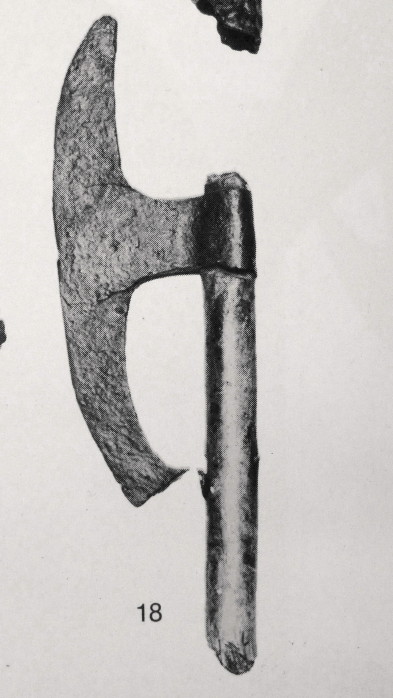
Picture of the original in Lahti museum booklet
 Attachment: 120.66 KB Attachment: 120.66 KB
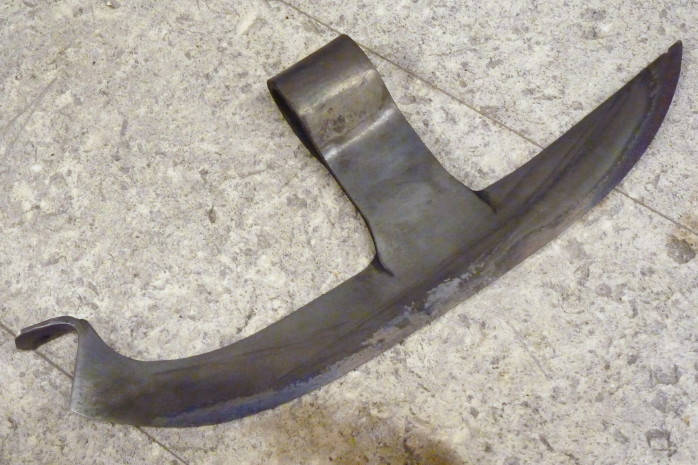
The bardiche heat-treated
 Attachment: 102.21 KB Attachment: 102.21 KB
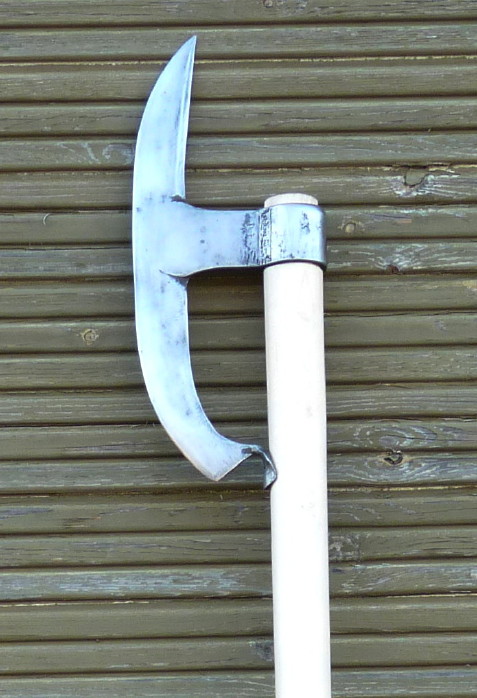
Haft in place, 'au naturel'
 Attachment: 116.63 KB Attachment: 116.63 KB

The bardiche with dyed haft, me as a size comparison
|
|
   |
 |
|
Mark Moore
|
 Posted: Mon 02 Jun, 2014 12:47 pm Post subject: Posted: Mon 02 Jun, 2014 12:47 pm Post subject: |
 |
|
Totally killer. I mean reeeeeally, totally killer. How much?...............McM
''Life is like a box of chocolates...'' --- F. Gump
|
|
  |
 |
Leo Todeschini
Industry Professional

|
|
   |
 |
J. Nicolaysen

|
 Posted: Mon 02 Jun, 2014 4:31 pm Post subject: Posted: Mon 02 Jun, 2014 4:31 pm Post subject: |
 |
|
|
I really like it. Serious in purpose, and efficient.
|
|
  |
 |
|
Jarno-T. Pälikkö
Industry Professional
|
 Posted: Tue 03 Jun, 2014 6:28 am Post subject: Posted: Tue 03 Jun, 2014 6:28 am Post subject: |
 |
|
Thank you for your comments fellas.
How much? ...Öööh, actually haven't thought of that! I did it as an "exercise" as I have never made such a piece before.
- And more importantly, what I have in mind is to prance around with the bardiche on my shoulder in one or two re-enactment happenings this summer! I think the sensible thing with such piece is to sell and ship it without the haft... But now I know I can make it, I feel comfortable in taking a bardiche as a commission.
Tod: I think you capped it pretty much there. The original bardiche is such a perfect wrap of simplicity and function, I just HAD to try my hand with the design.
Unlike most bigger, curvier bardiches, this one has one feature I particularly like: The end of the beard is usually fixed with thong or nailed to the haft with a smooth transition from the haft to the blade. With this, you have that wedge shaped end there with no possibility of your hand accidentally slipping on the cutting edge when wielding the axe.
...I wonder what a naginata trained person would make of this - would he/she find it wieldable?
Here's one more process picture - the parts roughly shaped before the forge weld.
JT
 Attachment: 144.68 KB Attachment: 144.68 KB
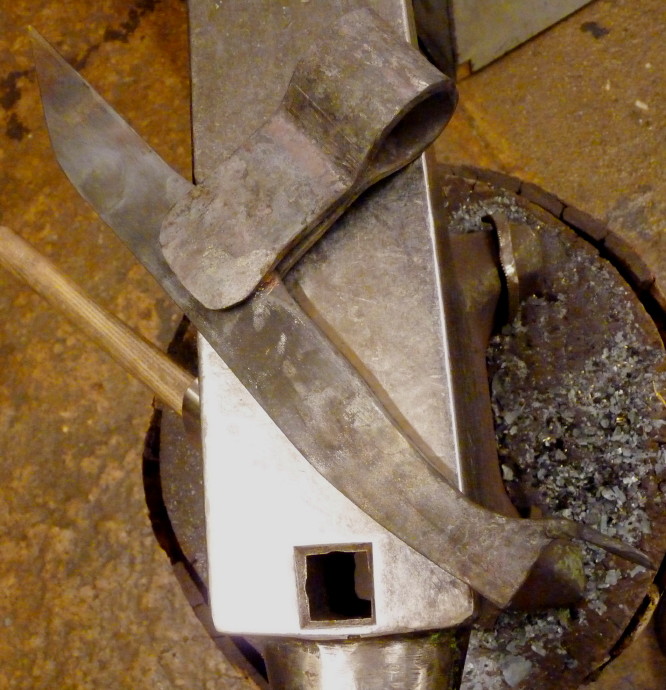
|
|
   |
 |
Jean Thibodeau

|
 Posted: Thu 05 Jun, 2014 3:49 pm Post subject: Posted: Thu 05 Jun, 2014 3:49 pm Post subject: |
 |
|
Very nice design and it looks light enough to be fast and lively while massive enough to be a reasonable good chopping axes, but the very pointy end and long sharp edge should make draw cuts and almost " Naginata Like use " highly effective in all probability.
One could also choke up on the shaft for use in a close melee in a more battlefield context .
The bottom heel of the blade should also be very good at hooking the edge of a shield and ripping it away leaving an opponent exposed to the point of the Bardiche or to the weapon one a fellow fighter in one's shield wall
You can easily give up your freedom. You have to fight hard to get it back!
|
|
  |
 |
|
Jarno-T. Pälikkö
Industry Professional
|
 Posted: Fri 06 Jun, 2014 4:07 am Post subject: Posted: Fri 06 Jun, 2014 4:07 am Post subject: |
 |
|
Thanks, Jean!
As you probably noticed, the haft thickens as it goes up towards the axe, With that extra weight I wanted to give a little more 'oomph' to the cutting edge.
Sure, the angled end of the blade can be used to grapple things with it. BUT it can also be a major draw-back if the distance of a drawing cut is miscalculated... Then again, this is one of those weapons that need only to connect with the target some way and some sort of damage has most probably been done.
- Then there is the parrying section of the bardiche, the straight area between the socket and 'the spike' - sturdy double-thickness area of steel for receiving and damaging other weapons' edges...
Of the sharpness of the blade: I am going to keep the edge relatively blunt as it is not the brightest idea to carry a razor-sharp pole arm in a crowd! Later I'll probably shapen the blade properly.
JT
|
|
   |
 |
Sean Flynt

|
 Posted: Fri 06 Jun, 2014 11:32 am Post subject: Posted: Fri 06 Jun, 2014 11:32 am Post subject: |
 |
|
I'm a big fan of polearms and reasonably well educated on the subject. I'd be delighted to own that piece. If you wanted some work to fund your own projects, I think you'd definitely find a market for that design and for the classic English bill, which is actually a bit simpler in construction. In fact, another member here is looking for a European smith to make a simple bill. I've wanted a good "munition" bill head for ages but haven't gotten around to commissioning one.
Well done!
-Sean
Author of the Little Hammer novel
https://www.amazon.com/Little-Hammer-Sean-Flynt/dp/B08XN7HZ82/ref=sr_1_1?dchild=1&keywords=little+hammer+book&qid=1627482034&sr=8-1
|
|
   |
 |
|
Jarno-T. Pälikkö
Industry Professional
|
 Posted: Thu 12 Jun, 2014 1:36 am Post subject: Posted: Thu 12 Jun, 2014 1:36 am Post subject: |
 |
|
Hi Sean, sorry for taking so long to answer.
I've been preparing stuff for an iron age happening and also finally got that katzbalger scabbard ready...
But of the bardiche: I will probably be allowed to take photos of the axe when I visit the museum again. So the next version of the bardiche would be much more accurate rendition of the original both in size and details. Wouldn't that sound rather more appealing?
The English bill is a very cool (for want of a better word) weapon, but all the variations of it I have come across have - in my view - much more complex structure than this particular bardiche. Could I ask what type of bill you are referring to?
JT
|
|
   |
 |
Sean Flynt

|
|
   |
 |
|
Jarno-T. Pälikkö
Industry Professional
|
 Posted: Fri 13 Jun, 2014 1:08 am Post subject: Posted: Fri 13 Jun, 2014 1:08 am Post subject: |
 |
|
Hello,
Thanks for the link, the how-to pictures of the manufacture of a bill are great!
As I figured, the back spike of the bill is forge welded to the body and the socket is likewise welded close. The welding process itself would not be a difficult one, but it requires a large fire to succeed.
Also, slightly intimidatingly, there is horrible amount of hammering involved in making such a bill, not to mention grinding afterwards. Nevertheless, it would be a cool thing to try to make sometime...
I still think the bardiche is easier to manufacture!
JT
|
|
   |
 |
Sean Flynt

|
|
   |
 |
|
Jarno-T. Pälikkö
Industry Professional
|
 Posted: Tue 17 Jun, 2014 4:28 am Post subject: Posted: Tue 17 Jun, 2014 4:28 am Post subject: |
 |
|
Greetings from iron-age! Just got back to the smithy, the Eura happening was a truly nice one this year. This time the weather was just perfect for the occasion.
Let's see if I get myself to make a version of the bill sometime, in the not too distant future. If I do, I'll probably make a thread out of it here, in the forum...
JT
|
|
   |
 |
|
Jarno-T. Pälikkö
Industry Professional
|
 Posted: Mon 23 Jun, 2014 1:15 am Post subject: Posted: Mon 23 Jun, 2014 1:15 am Post subject: |
 |
|
Hi, fixed the haft in place yesterday.
So here is my Luumäki-style bardiche in all its "glory". You'll notice that the nail going through the haft at the end of the 'beard' is overlength and the extra is bent upwards. Now an idea comes to mind, that a sturdy, over-long nail might act as a rudimentary spike or stopper when it is just hammered through the haft and left straight....
Trying to find something similar to this bardiche, I have come across with a term "sparth axe", the term is unfamiliar to me - can somebody explain the difference between "sparth axe" and bardiche? Also, the Danish axe and beard-axe have been mentioned when referring to such long hafted, broad-bladed axes...
JT
 Attachment: 114.85 KB Attachment: 114.85 KB
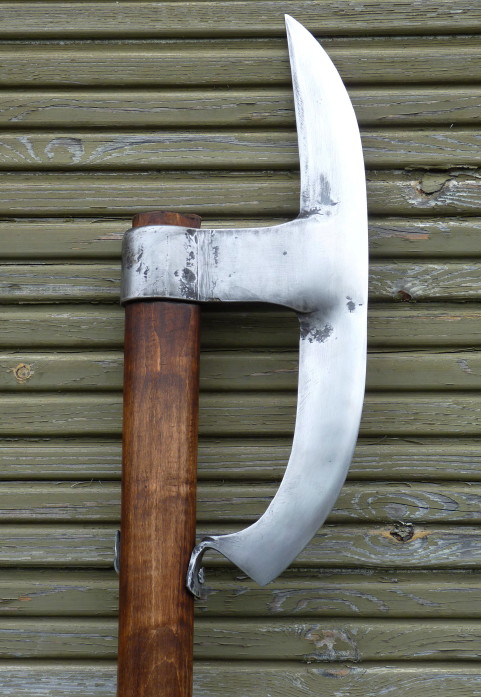
|
|
   |
 |
|
|

